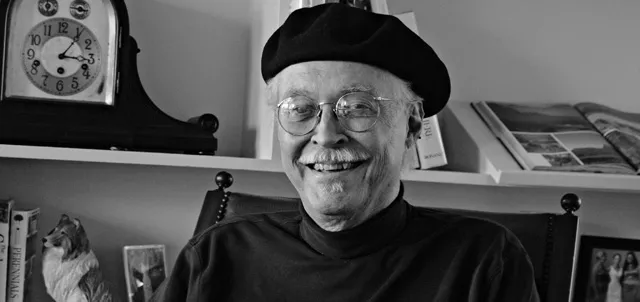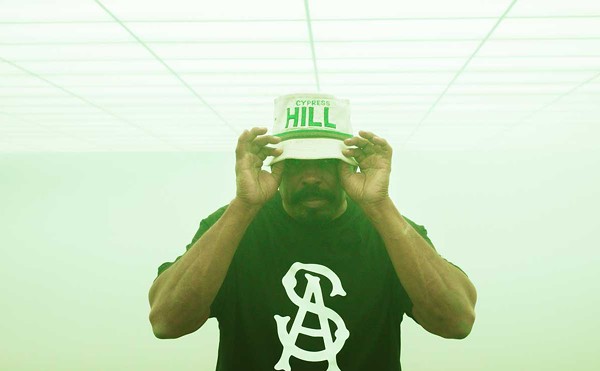
If you know the Detroit jazz scene, you may recognize Doug Halladay as a cat who's often around it. If you go back far enough, you know him as a trumpeter. But his music takes center stage this week like never before in New Beginnings: A Jazz Benefit to Fight Leukemia. It brings together his compositions, 25 of his peers, his activism and his fight against his disease. He sat in his Lafayette Park home the other day, explaining how these threads have intertwined.
A year and a half ago they diagnosed me with leukemia. They said we need to start chemotherapy or you'll be dead in six weeks. And my only opportunity to live later was a bone marrow transplant. This is my one-year anniversary of the transplant — May 5. And here I am. I'm in remission. I have a new grandson. And my daughter Alexandra is graduating from University Liggett High School.
I'd been running "cover the uninsured week" and stuff and working for the Robert Woods Johnson Foundation, really fighting for health care reform for the last eight or nine years. And there I was sick in the hospital, seeing things firsthand. It didn't take long to appreciate what these nurses and physicians do every day. I've been in intensive care and almost didn't make it. I've been in and out of the hospital for various infections. And so I wanted to do something to pay back. Last July I had a group of friends together and we started talking ...
Halladay came to Detroit in 1967 to pursue a graduate degree in urban sociology at Wayne State University. But there was another pull ...
Immediately I got into the musical scene. I'd say from 1965 to 1975, a 10-year span in there, was one of the more unique periods in the history of jazz. First of all, nationally, Miles and Wayne Shorter and those guys were setting the bar really high. In Detroit you had Strata Gallery with Charles Moore and Kenny Cox. You had Tribe. You had Larry Nozero's group. You had Focus Novi with James Blood Ulmer and Patrick LaNier. You had the Detroit Creative Musicians Association. The hip thing is that the black and white musicians were collaborating in a way that you really haven't seen since. It was a vibrant time. ...
It was a time of high hopes and high energy. Musicians were running their own spaces and labels, and ...
Everybody was writing music. We saw that the music can change. People were playing and writing in different meters. No longer were people playing straight up in four and three. We were experimenting in playing in sevens and polyrhythms, and everybody in town was doing it. Doug Hammond would call a rehearsal and have 10 musicians down in his basement to play some new charts he'd written.
The power of that era's music comes across most strongly when Halladay talks about playing through a storm.
When I first came here in '67, I played in a band here with Larry Nozero every day for almost two years. There was Keith Vreeland on piano, John Dana on bass, different drummers. We played an after-hours gig at one of these lofts; it went until 4 in the morning and didn't start till midnight. We were playing a waltz called "Moon" that David Durrah had written. It was thundering and lightning out. Larry and I had played so much together that we could breathe at the same time ... we knew each other and we knew how we played. And all of a sudden a big lightning bolt hit, and the music stopped — but the beat kept going on. And when it stopped thundering and lightning, the whole band just picked up the tune where it left off. And then it would roar and thunder, and we'd stop and pick up the line. That's the kind of thing I remember. We were young and the music was everything.
Halladay, though, stopped performing as the '70s wore on. There was a family to provide for. He didn't want to play music he didn't like just for the bread. There were other considerations too. He was frustrated by the gap between his playing ("I was an average trumpet player") and his aesthetic ("way up here," he says, putting his flattened hand above his brows). There were other dissatisfactions.
I don't like playing with musicians that play everything they know all the time. I'd say, look, strive to become like amateurs. Many cats are so predictable; they have their formula and the things they know how to do and they do them very well. I always felt that the thing that's most creative is to be creative and play something that you don't know. Take a risk.
But aside from short-lived returns to performing, Halladay's main musical expression in subsequent years has been composing. Some pieces slated for Thursday date back to his active-gigging days; most were written later. Now he's gathered an all-star cast to perform them. The pianists Buddy Budson, Charles Boles, Keith Vreeland and Gary Schunk lead bands including another 20 or so Detroit all-stars, such as Marcus Belgrave, Ursula Walker, Steve Wood, Ron English and Dwight Adams.
Away from music, Halladay worked at a range of jobs including stints with public TV's adult ed programs and with Wayne State's lifelong learning efforts. He worked with the Annenberg Foundation on Detroit school reform and with Robert Woods Johnson on health care reform. Yet, when he looks at his city, he finds it hard to be "a glass half-full person."
I'm tired of butting my head up against this resistance to change. God damn. We can't clean up to the garbage and turn on the lights. Young people are leaving. There's no green space. There's no shopping. No place to send your kids to school. Why would you want to be here? The art scene, I think, that's one of the attractive things and when I stand there and I look at all these musicians. I mean, where would Detroit be without musicians of this caliber who are part of the lifeblood of this city?
Besides raising money, the program aims to raise awareness of bone marrow registries (joining can be as simple as a mouth swab) and being a donor (often by a procedure similar to blood donation). Halladay's salvation came from a 23-year-old German matched through an international database. But for someone of European stock like himself — compared to African-Americans, Middle Easterners, Asians and others — the registries offer more potential matches, so there's more work to be done. And, he recalls saxophone great Michael Brecker, also a leukemia victim, for whom a good match couldn't be found. Brecker died four years ago at age 57.
As to the title of the program, the "new beginning," Halladay explains it on several levels. This "hell of an experience" has given him a new appreciation of life, drawn him closer to his family, inspired him. He recalls one of the last conversations he had with the pianist Kenny Cox, who passed away in 2009.
I'm retired now, I don't have to worry about the world of work, and I can devote my time to my music. You're going to be hearing some other things that I'm going to be doing. Kenny said to me, "Now's the time, what are you waiting for?"
New Beginnings is at 8 p.m. Thursday, May 5, at the Max M. Fisher Music Center, 3711 Woodward Ave., Detroit; 313-576-5111. Tickets are $35 and $50 (includes afterglow). Proceeds go to the Children's Leukemia Foundation of Michigan.
Thanks to Metro Times editorial intern Alia Raheem for transcription assistance.





